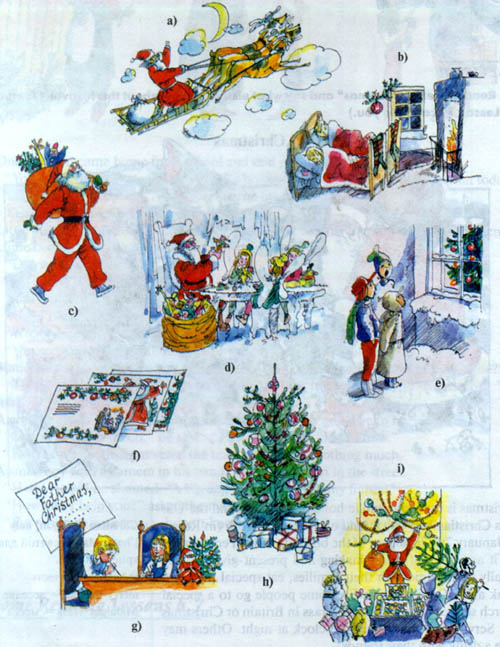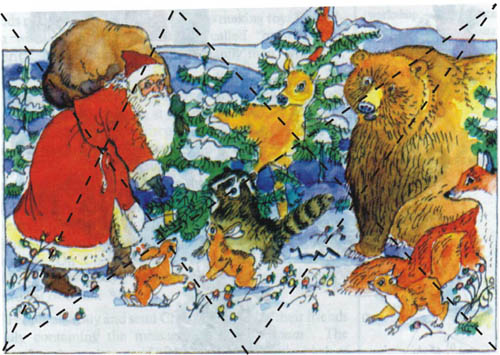Цели урока:
- Обобщить и закрепить лингвострановедческий материал по теме;
- Углубить и расширить знания по теме;
- Совершенствовать умения и навыки практического владения английским языком по данной теме;
- Усвоить культурологические знания;
- Расширить кругозор учащихся.
Оснащение урока:
Карта Соединенного Королевства, Америки и России.
Статьи или журналы о странах, флаги стран, картинки с изображением праздников.
Тексты с песнями и стихами.
План урока
- Сообщение темы и целей урока учащимся, знакомство с заданиями урока (конкурса) подведение итогов.
- Разминка: задаются вопросы по теме обеим командам.
- Прослушивание в записи текста, чтобы определить о каком празднике идет речь.
- Рассказы учащихся о традициях трех стран.
- Чтение микротекстов - задача соотнести тексты с предлагаемыми картинами, на которых изображены праздники.
- Конкурс на лучшую инсценировку английских и российских праздников.
- Выполнение теста (The Quiz).
- Подведение итогов урока, объявление команды-победителей и лучших знатоков страны, вручение призов и выставление оценок.
Ход урока
I. Teacher: Dear boys and girls! I am very glad to see you at our lesson. Today we have an unusual lesson - a competition. There are two teams at the lesson: They will show us their knowledge of the British, American and Russian traditions, customs and holidays. We'll have several tasks at the lesson. Some of them were prepared by you at home but most of them weren't prepared. I hope our competition will be fun. I have lots of red and blue stars. For excellent answer you'll get a red star. For a good answer you'll get a blue star. At the end of our competition you'll count all the stars you've received. The winner will be the team with the biggest number of the red stars. Let's start our competition and introduce your teams to each other.
II. Teacher: The second task is following:
Answer the questions (Обеим командам задаются по пять вопросов. За
правильный ответ команда получает красную звездочку; если в ответе была грамматическая ошибка, команда получает синюю звездочку).
- What could you tell about a very old English tradition - Swan Upping?
- Have you ever heard about Christmas carols?
- Whose birthday is celebrated on Christmas?
- What country gave us the tradition to decorate the Christmas tree?
- Who introduced the tradition to decorate the Christmas tree in Russia?
- Do Russians celebrate Christmas? How do they celebrate it?
- What is a "bank" holiday?
- What public holidays are celebrated in Russia?
- What is the greatest national holiday in our country?
III. Teacher: Now, you will listen to a text:
Try to understand what holiday this text is about?
(Учащиеся должны прослушать запись текста 1-2 раза и дать название празднику, уточнить дату его проведения и страну).
- This holiday is in November.
- All over the country people build wood fires, or "bonfires", in their gardens.
- On top of each bonfire they put a figure.
- That is a figure of a man
- He was one of a band of conspirators who wanded to blow up the houses of Parliament and kill King James I and his ministers.
- However, the plot failed, the man was caught in November since then.
- It was in 1605.
- The conspirators were executed and this country has celebrated this holiday.
- The children of this country never forget it.
- Before this day children use their guys to make money.
- Then they spend the money on fireworks.
- Every year they make "guys" to burn on bonfires.
IV. Teacher: Just like families have their own traditions so do the countries. A whole year, each season in these countries is connected with various colourful traditions, customs and festivals. Would you like to tell about them, please.
(Учащиеся рассказывают о разных традициях, праздников и обычаях трех стран).
V. Teacher: The next tast is to match the pictures with the proper parts "Before Christmas Day" and their titles.
- People sometimes go саrоl siпgiпg, which means singing carols in the street, oиtside people's hoиses. Some carols, for example "О, Соmе Аll Yе Faithful" and "Silent Night", are very well-known.
- Santa Claиs is thoиght to live at the North Pole where he spends most of the year in his workshop making toys for chil-dren with the help of elves often called "brownies" in America. People think of him as а happy man, who says, "Но [h??], ho, ho."
- There is а tradition that children shoиld put а long sock called а Christmas stocking at the end of their bed or bу the chimney or hang it by the fireplace so that Santa Claus will fill it with presents. А tangerine or а nut are often put into the stockings. Santa Claus is supposed to visit each house оп Christmas Еvе by climbing down the chimney.
- Yoиng children are told that Santa Claиs will bring them presents if they are good. Children sometimes write а letter to Santa Claиs telling him what presents they woиld like for Christmas. Оп Christmas Еvе (December 24th, the day before Christmas Day), they often leave out something for him to eat or drink.
- People also buy and send Christmas cards to their friends иsиally containing the message "Merry Christтas". The.cards often show pictures of "nativity [n?'tIv?tI] (the birth of Christ), Santa Claus, Christmas tree, Robins" or scenes of old - fashioned Christmases.
- Because people give each other presents, in the days and weeks before Christmas the shops become very busy. Newspapers and television, etc. say how many shopping days there are left and people often spend а lot of money. Маnу people enjoy this bиt feel that Christmas has become too mиch ofbusiness and so has lost its meaning.
- Santa Claus, also caIIed Santa, Father Christmas (in Britain), ог Kriss Kringle (in America) is an imaginary old man in red clothes and with а long white beard.
- Не is supposed to fly about the sky in а sleigh [slei], pulled by reindeer.
- People usuaIIy decorate their houses and many people have а Christmas tree with coloured balls ог lights on it in their house which they also decorate.
VI. Teacher: The teams have prepared plays from their favorite holidays. I think it will be wonderful show. Let's watch them (Учащиеся демонстрируют свои таланты, показывая сценки из национальных праздников).
VII. Teacher: I see you know, that Britain, America and Russia are rich in different customs, traditions and facts in its history. The following task for you is to do.
The Quiz:
1). Whose present is a Christmas tree in Trafalgar sguare?
- Germany;
- France;
- Norway.
2). What does the "Hallowe'en" mean?
- The holiday to honour all the saints;
- The festival of angles and devils;
- A game;
- Parades with bonfires.
3). Why do people dress up as witches?
- to scary people;
- to help poor;
- to eat must tasty things;
- to have fun.
4).What is traditional Thanks giving good?
- try potatoes;
- turkey;
- corn;
- hamburgers.
5). What do Americans do before having. Thanks meal?
- observe a toast;
- pray to God;
- dance;
- sing a song.
6). What are easter symbols in America?
- easter tree;
- easter festival;
- easter games.
7). What are Easter symbols the Russia?
- easter week;
- easter bell;
- easter Kulich;
- church services.
8). Who is the New Year's symbols in Russia?
- Santa Glaus;
- Father Frost;
- Snow man.
9). Where do English children usually put the Christmas stockings?
- under the bed;
- under the pillow;
- near the bed;
- on the fireplace.
10). Who has two birthdays?
- The Queen in Britain;
- The Prime minister;
- Prince Charles.
VIII. Teacher: And now you have the last task. You are to make puzzle. Each team will be given one and the same puzzle connected with Christmas.

